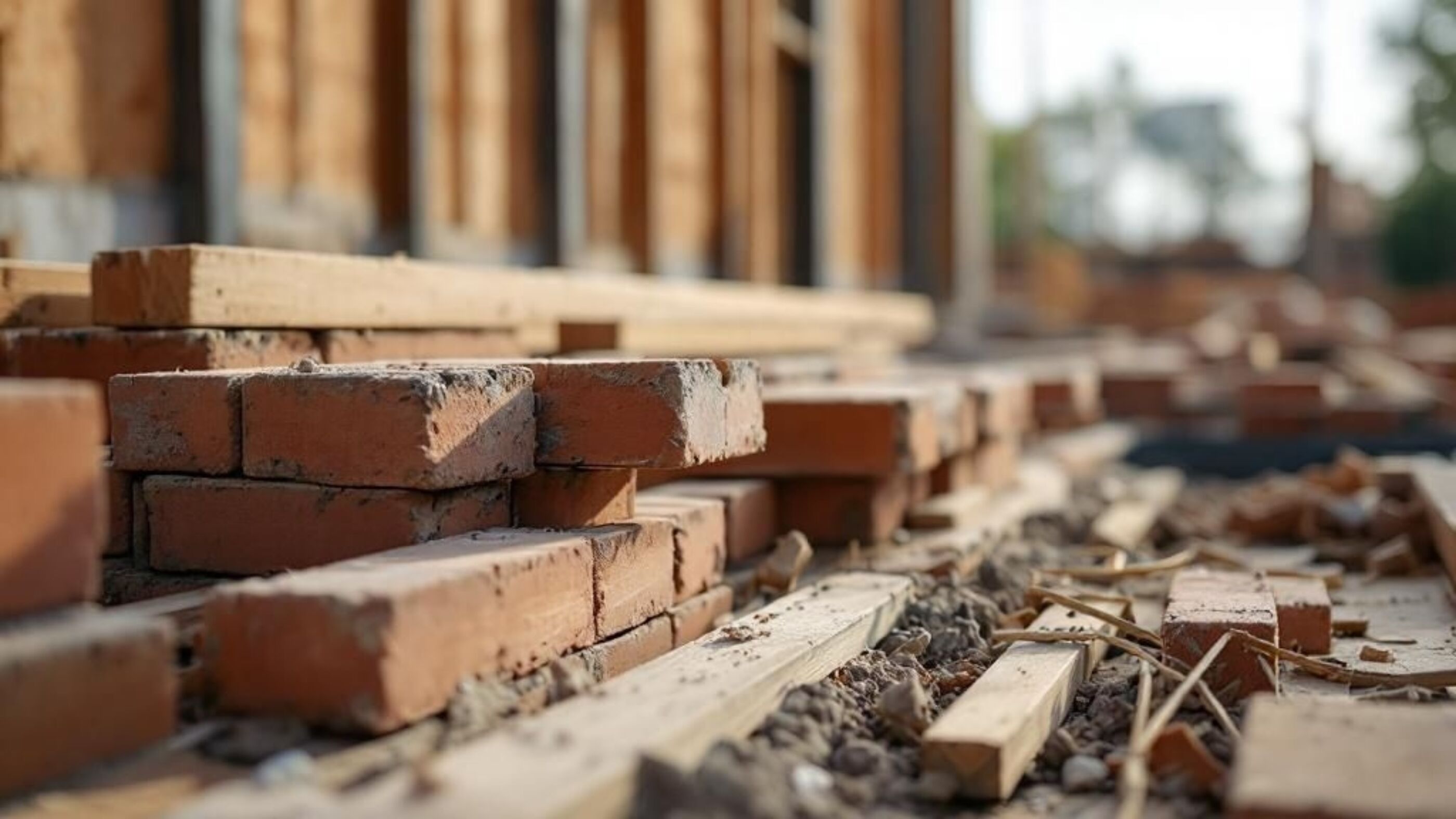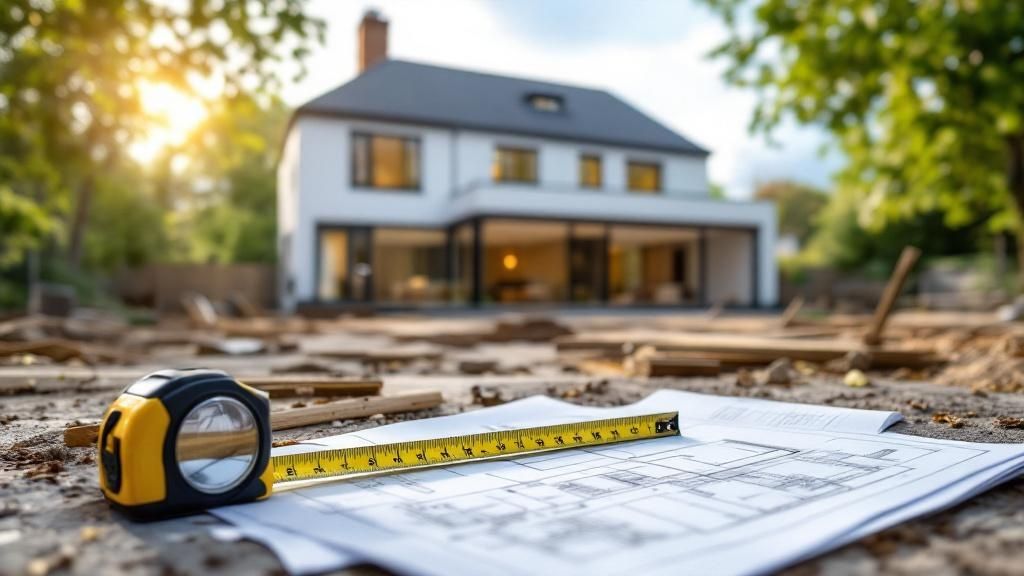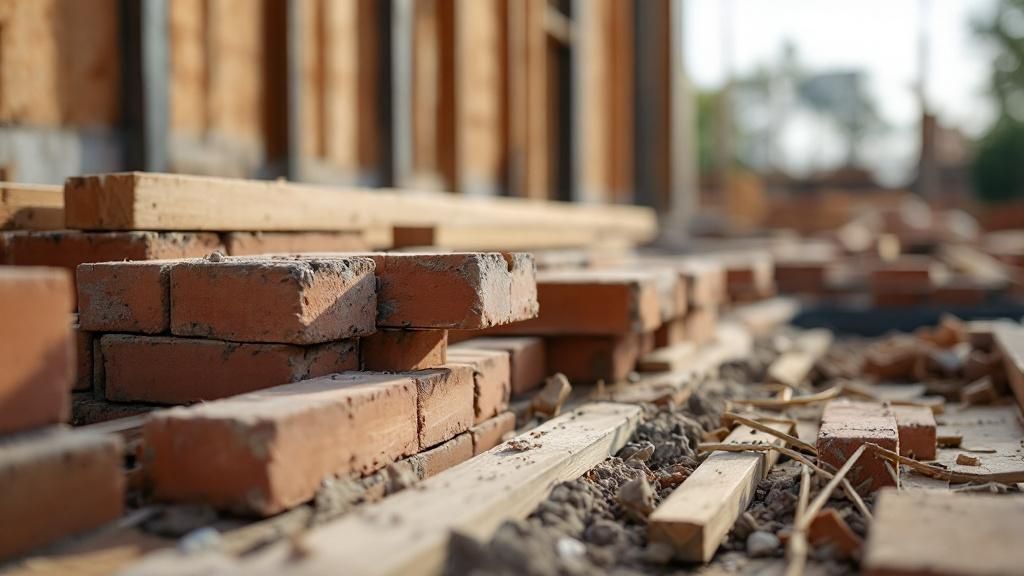Ground Floor Extension Cost: Complete Australian Guide

Understanding Real Ground Floor Extension Costs Across Australia
Planning a ground floor extension is an exciting project. But before you start picking out paint colors and furniture, it's crucial to understand the real costs involved. Building an extension in Australia requires careful budgeting and planning. Let's explore what you need to know about the expenses you can expect.
Decoding the Price Tag
How much will a ground floor extension really cost? Unfortunately, there isn't one simple answer. The final price depends on various factors, including your location, the size of the extension, and the complexity of the design.
While the average might sit around $300,000, the actual expense can vary significantly, from as low as $150,000 to upwards of $450,000. This wide range highlights the importance of thorough planning and gathering multiple quotes from different builders. Market fluctuations also play a role, so staying up-to-date on current construction costs is essential.
You can also explore specific extension services offered by companies like Envy Abode.
Regional Variations and Cost Drivers
Where you live has a big impact on your extension's final cost. Construction in major cities like Melbourne tends to be more expensive than in regional areas. This is often due to higher labor costs and greater demand for building services. For instance, a ground floor extension in Melbourne could potentially cost double the price of a comparable project in a regional town.
Understanding Cost Per Square Metre
Calculating the cost per square metre can be a helpful way to compare different projects and assess value. While average figures provide a starting point, getting specific quotes tailored to your individual project is essential.
A basic extension might cost between $3,800 and $6,500 per square metre. So, an 80 square metre extension could range from $304,000 to $520,000, depending on the finishes and features you choose. This considerable price difference emphasizes the importance of detailed quotes.
However, remember that focusing solely on the cost per square metre can sometimes be misleading. A smaller, high-specification extension might have a higher per-square-metre cost than a larger, more basic one, even if the total price is lower. The key is to strike the right balance between size, features, and budget to achieve your desired result.
To help illustrate the cost variations across Caulfield, let's take a look at the table below:
Ground Floor Extension Cost Ranges by State
Comparison of average costs per square metre across major Australian cities and regions
State/Territory | Average Cost per m² | Budget Range | Premium Range |
New South Wales (Sydney) | $4,200 - $7,000 | $3,200 - $5,000 | $5,200 - $8,500 |
Victoria (Melbourne) | $3,800 - $6,500 | $3,000 - $4,800 | $4,500 - $8,200 |
Queensland (Brisbane) | $3,200 - $5,200 | $2,700 - $4,300 | $3,900 - $6,000 |
Western Australia (Perth) | $3,500 - $5,000 | $2,400 - $3,800 | $3,100 - $5,800 |
South Australia (Adelaide) | $3,200 - $4,500 | $2,400 - $3,800 | $3,300 - $5,200 |
Tasmania (Hobart) | $3,000 - $4,300 | $2,500 - $3,200 | $3,000 - $4,900 |
As the table demonstrates, costs can differ substantially between states and territories, with Melbourne generally exhibiting very high average costs and Tasmania showing the lowest. This information provides a helpful benchmark when starting your budgeting process. Remember to obtain specific quotes from builders in your area to get a more precise estimate for your ground floor extension project.
The Hidden Factors That Control Your Extension Budget

While size and materials are major factors in the cost of your ground floor extension, other less obvious elements can significantly impact your final budget. Being aware of these hidden costs is essential for accurate planning and avoiding unexpected financial surprises.
Site Conditions and Access
The specific characteristics of your site play a crucial role in determining the complexity, and ultimately the cost, of your extension project. A sloping block, for example, might require substantial excavation work and the installation of retaining walls, adding significant expense.
Limited access to your property can also complicate matters. Difficult access can increase labor costs due to challenges with material delivery and waste removal. This means even seemingly straightforward projects can become more complex and expensive due to challenging site conditions.
Integrating With Your Existing Home
Creating a seamless blend between your new extension and the existing structure involves more than just aesthetics. Connecting to existing plumbing, electrical, and heating systems can be a complex and costly undertaking.
This is especially true in older homes, where outdated services may require upgrading to meet current building codes. Tying into old plumbing, for instance, could necessitate replacing sections of pipework, adding to your overall budget.
Design Choices and Their Cost Implications
Certain design features can significantly impact the cost of your extension. Complex rooflines, large expanses of glass, and bespoke joinery can be visually stunning, but they often come with a higher price tag.
Simpler, more standardized design elements can be equally effective while keeping costs in check. Carefully considering the cost implications of your design choices is crucial. For more detailed information, check out our guide on estimating extension costs.
Timing and Structural Requirements
The timing of your project and any unforeseen structural issues can also influence your budget. Building during peak season often leads to higher labor and material costs due to increased demand.
Additionally, uncovering unexpected structural problems during construction, such as asbestos or unstable foundations, can lead to substantial cost overruns. Thorough planning and budgeting are crucial to managing these potential challenges. The cost of ground floor extensions in Australia is influenced by various factors, including size, materials, and location. A single-story extension might cost between $3,800 and $6,500 per square meter, depending on the design's complexity and the chosen building materials.
Strategic Size and Design Decisions That Maximize Value

When planning a ground floor extension, size and design are crucial for maximizing value and achieving your lifestyle goals. It's not simply about adding more square footage; it's about optimizing the cost per square meter while creating a beautiful and functional space. This requires balancing your aspirations with your budget and the characteristics of your property.
The Impact of Extension Size on Project Economics
The size of your extension directly impacts the overall cost. A compact 25m² kitchen extension will naturally cost less than a larger 120m² family living area. However, the cost per square meter can sometimes be lower for larger extensions because of economies of scale.
Fixed costs, such as council permits, are distributed across the total area. This can make larger projects more cost-effective per square meter.
Thinking about the potential return on investment is also important. A small addition might not significantly increase your property's value compared to the cost. Conversely, an excessively large extension could overcapitalize your property relative to the local market.
Open-Plan vs. Multi-Room Layouts
A key design decision is choosing between an open-plan or multi-room layout. Open-plan designs offer a sense of spaciousness and flow, making them a popular choice. They can, however, be more expensive to heat and cool.
Multi-room layouts offer greater privacy and flexibility. This can be ideal for families or those who work from home. However, they might require more walls and doors, potentially increasing construction costs.
The best choice depends on your lifestyle and budget. A family with young children might prioritize an open-plan design, while someone working from home might value the quiet focus of a dedicated office. Carefully consider how you'll use the space.
Maximizing Natural Light and Indoor-Outdoor Flow
Smart design choices can enhance the value of your extension without dramatically increasing costs. Maximizing natural light creates a brighter, more inviting space and can also lower energy bills. This can be achieved with strategically placed windows, skylights, and glass doors.
Creating a seamless indoor-outdoor flow extends your living space and connects you with nature. Bi-fold doors leading to a patio or deck are a great example. These features not only enhance liveability but also contribute to a higher perceived value.
Designing for Future Flexibility
While focusing on your current needs is important, consider the future too. Designing for flexibility helps ensure your extension remains functional and valuable for years to come. A guest bedroom, for example, can easily be converted into a home office if needed.
Adaptable spaces can accommodate evolving family dynamics or changing lifestyle needs. Explore further design options. These forward-thinking design choices enhance long-term value and minimize the need for expensive renovations in the future. Carefully considering these strategic decisions can ensure your ground floor extension delivers the best possible return on your investment. Don't forget to consider house extension plans to visualize your future space.
Material Choices That Make Or Break Your Budget

From flooring and windows to roofing and fixtures, the materials you choose have a big impact on the overall cost of your ground floor extension. Understanding the cost differences between various options is essential for staying within your budget and creating a space you'll love.
Flooring Foundations: Balancing Cost and Durability
Flooring is a significant part of any ground floor extension, and the choices can feel overwhelming. There's a wide range of options, from budget-friendly to luxurious. Engineered timber provides the beauty of hardwood at a lower cost, while solid timber offers unmatched longevity.
Tiles are a popular choice, with porcelain and ceramic available in various styles and prices. For a cost-effective option, laminate flooring offers the appearance of wood or tile at a fraction of the price. While laminate might not offer the same lifespan as premium materials, it can be a great way to achieve a certain look without breaking the bank.
The key is to balance your budget, your aesthetic preferences, and how long you want the flooring to last.
Windows and Doors: Letting Light In on the Budget
Windows and doors play a crucial role in your extension's overall look, energy efficiency, and cost. Double-glazed windows, while more expensive upfront, offer excellent insulation and can save you money on energy bills in the long run.
The material of your window frames also impacts both style and cost. Aluminium frames are known for their durability and low maintenance, but they're typically more expensive than uPVC, a budget-friendly alternative. For more inspiration, check out this article: How to master your extension design.
Roofing and External Finishes: Weathering the Costs
Your roofing and external cladding choices influence both the curb appeal and weather resistance of your extension. Colorbond roofing is a popular choice in Australia, known for its durability and protection against harsh weather.
Tiled roofing offers a premium look but comes with a higher price tag. Similarly, brick veneer offers a classic aesthetic and good insulation, while fibre cement provides a more budget-friendly option. Choosing materials suitable for Australian conditions is crucial for long-term performance and minimal upkeep.
Fixtures and Fittings: The Finishing Touches
Those final fixtures and fittings, from tapware and lighting to appliances, can significantly affect the overall cost. High-end options can quickly add up, but opting for more budget-friendly choices doesn't necessarily mean compromising quality.
Many reputable brands offer excellent products at competitive prices. Prioritizing quality in essential areas like plumbing fixtures can prevent costly repairs later. Focus on striking the right balance between style, functionality, and budget.
Making Informed Decisions
To help you make informed choices, let's look at a cost comparison for various materials. The table below outlines the costs for different material grades across key components of a ground floor extension.
Component | Budget Option | Mid-Range Option | Premium Option | Cost Difference |
|---|---|---|---|---|
Flooring | Laminate ($80/m²) | Engineered Timber ($130/m²) | Solid Timber ($180/m²) | $80-$180/m² |
Windows | uPVC (Double-glazed $800/unit) Aluminium (Double-glazed $800/unit) | uPVC (Double-glazed $1200/unit) | Timber (Double-glazed $1800/unit) | $800-$1800/unit |
Roofing | Colorbond ($120/m²) | Terracotta Tiles ($130/m²) | Slate Tiles ($200/m²) | $120-$180/m² |
External Cladding | Fibre Cement Sheet ($120/m²) | Brick Veneer ($180/m²) | Metal Cladding ($650/m²) | $120-$650/m² |
As you can see, the cost differences can be substantial. Choosing premium materials may increase the initial cost but could also add value to your property and reduce maintenance expenses over time.
When selecting materials, consider your long-term goals. Consulting with a qualified builder or architect can provide valuable insights and help you make the best decisions for your project and budget.
Navigating Planning Costs and Approval Requirements
Embarking on a ground floor extension is an exciting project, but understanding the planning and approval process is crucial. This phase can significantly impact your overall ground floor extension costs. Let's explore the steps involved and the associated expenses.
Understanding the Approval Process
The approval process typically involves several key stages. It begins with consultations with building designers and draftspeople. These professionals help translate your vision into tangible plans and drawings. This initial design phase can cost between $5,000 and $10,000, depending on the project's complexity.
After finalizing your plans, you'll submit them to your local council for approval. This usually involves paying application fees, which can vary based on the council and the project's size. Expect to pay between $500 and $2,000 for these fees.
Engaging Specialists and Assessments
Some projects require input from specialists. For instance, complex designs or specific soil conditions might necessitate a structural engineer. Engaging one can add between $2,000 and $4,000 to your budget.
If your property is in a heritage-listed area, you might need to consult with a heritage consultant. This ensures your extension complies with regulations protecting the area's historical integrity. Heritage consultations can cost between $1,500 and $4,000.
Some councils also require a geotechnical assessment. This assessment analyzes the soil and ground conditions to ensure your extension's stability. Budget between $800 and $1,500 for this.
Managing Approvals and Potential Delays
Navigating council requirements can be intricate. Approvals sometimes take longer than expected. Delays can increase costs, especially if you need temporary accommodation.
Working closely with professionals and understanding the requirements upfront can help expedite the process. Be prepared for potential plan revisions based on council feedback. Budgeting for at least one revision helps avoid unexpected expenses.
Minimizing Costs and Ensuring Compliance
While the approval process can seem complicated, there are ways to minimize costs and ensure compliance.
Thorough Planning: Invest time upfront researching local council regulations and discussing your project with experienced professionals. This helps anticipate potential issues and avoid costly revisions.
Clear Communication: Maintain open communication with your architect, builder, and council representatives. This prevents misunderstandings and keeps the project on schedule.
Professional Guidance: Engaging a building surveyor early can clarify compliance requirements and avoid potential construction issues.
By following these tips, you can navigate the approvals process effectively, setting your ground floor extension project up for success and keeping it within budget.
Protecting Your Budget From Unexpected Costs
Even the most meticulously planned ground floor extension can run into unforeseen expenses. These unexpected costs can quickly derail budgets and timelines, leading to stress and frustration. Understanding the most common pitfalls, and knowing how to mitigate them, is crucial for a smooth renovation.
Common Hidden Costs
Several hidden costs often catch homeowners unaware. Underground utility relocations, for instance, can represent a significant, and often unanticipated, expense. Discovering underground pipes or cables during excavation can necessitate rerouting, adding unexpected costs to your project.
Another frequent issue is the discovery of unexpected structural problems. Older homes, in particular, may hide structural issues that only surface during demolition or construction. Addressing these issues can add substantial time and expense to the project.
Site access challenges can also drive up costs. Difficult property access complicates material delivery and waste removal, resulting in higher labor costs and potential delays. Also, consider the potential need for temporary accommodation. If your extension makes parts of your home uninhabitable during construction, factoring in these living expenses is essential.
Contingency Planning: Your Financial Safety Net
Experienced renovators know the importance of contingency planning. Setting aside a buffer of 10-15% of your overall budget helps cover unforeseen expenses. This financial safety net provides peace of mind and helps avoid project delays due to unexpected costs.
Minimizing Financial Surprises
Several strategies can help minimize the risk of financial surprises. Thorough site surveys conducted before construction begins can identify potential issues like underground utilities or difficult access. Obtaining multiple quotes from reputable builders provides a realistic understanding of costs and allows for comparison of different approaches.
Clear communication with your builder is paramount. Discuss potential challenges and agree on a plan for handling variations or unexpected discoveries upfront. A detailed contract outlining payment schedules and responsibilities protects both you and the builder.
Managing Variations and Temporary Accommodation
Variations, or changes to the original scope of work, often arise due to unforeseen circumstances or client requests. Managing variations effectively is critical for staying on budget. Agree on a clear process for approving and documenting any changes, including associated costs.
If your extension requires temporary accommodation, factor this expense into your budget from the outset. Researching options and securing accommodation in advance can help control costs and minimize disruption to your family. This foresight ensures a smoother, less stressful renovation experience. Remember that managing a ground floor extension involves more than just the construction itself. Careful planning, realistic budgeting, and open communication are key to achieving your desired results without jeopardizing your financial security.
Proven Strategies For Maximizing Your Extension Investment
Building a ground floor extension is a significant financial commitment. Maximizing that investment requires careful planning and informed decisions. Here are some proven strategies from successful renovators to help you achieve the best possible results while respecting your budget.
Timing Your Project Strategically
When you decide to build can significantly impact your ground floor extension cost. Construction during the busy season often leads to higher prices for both labor and materials due to increased demand. Think about scheduling your project during the quieter months (typically winter) for potential cost savings.
Choosing the Right Contractor
Selecting the right contractor is essential. Don't make your decision based only on the lowest quote. Look for builders with a demonstrable history of quality workmanship and open communication. Check references and online reviews. A reputable builder can guide you through the process and provide helpful advice on budget-friendly solutions.
Structuring Payments to Protect Your Interests
Create a clear payment schedule tied to specific project milestones. This protects you from overpaying and helps ensure the builder stays on schedule. Avoid large upfront payments. Structure payments based on completed stages of the project. This maintains financial control and ensures accountability.
Exploring Cost-Effective Alternatives
There are often budget-friendly options that don't compromise on quality. For instance, instead of pricey custom joinery, consider pre-fabricated options. These can offer significant savings without sacrificing style or function. You might be interested in: How to master house extension plans.
Negotiating Effectively
Don't hesitate to negotiate with your builder. A good builder is willing to discuss costs and find solutions within your budget. Be upfront about your budget limitations and explore potential trade-offs.
Identifying DIY Opportunities
While some tasks demand professional skills, certain parts of your extension might be suitable for DIY. If you're handy, consider tackling tasks like painting or landscaping yourself. This can reduce costs and add a personal touch.
Phasing Your Construction
If your budget allows, think about phasing your construction. This breaks the project into smaller, manageable phases, distributing the costs over time. This approach makes the overall investment more manageable and provides flexibility if your needs evolve.
Value Engineering: Getting More for Your Money
Value engineering involves identifying ways to reduce expenses without compromising quality or functionality. This might involve using alternative materials or simplifying design elements. A skilled builder can provide valuable insights into value engineering options.
By using these strategies, you can turn your ground floor extension dreams into reality while maximizing your investment and building equity in your home. Ready to begin your dream extension project? Contact Envy Abode today for a consultation: https://envyabode.com.au